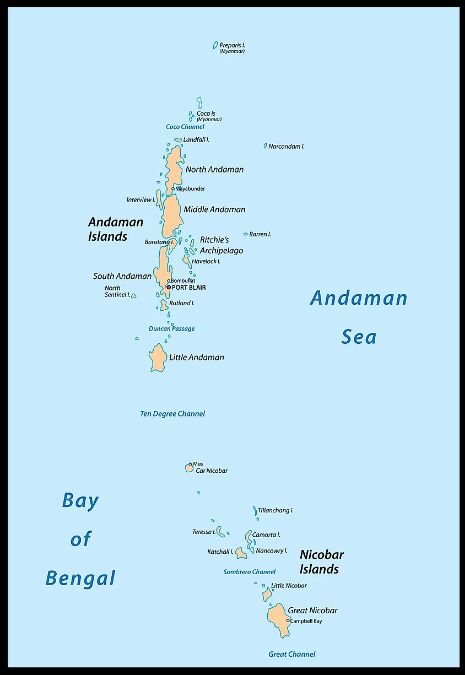An island for 'convicts'
Strategically important and resource-rich Andaman Islands, confirmed for penal settlements by the British, received a major fillip post-1857 revolution with the deportation of convicts of ‘remarkable degree of agency’ and ‘self-resect’

Andaman and Nicobar are two archipelagos comprising 572 islands/islets located in the Bay of Bengal, of which only 25 in Andaman and 12 in Nicobar are inhabited. Together they provide India a great strategic advantage over the Straits of Malacca — one of the most important 'Sea Lane of Communication' (SLOC) — critical to trade and movement of oil from the Gulf to the South China Sea, East China Sea and the Pacific. These islands also provide India with tremendous economic potential for tourism, fishery and deep-sea exploration for oil and gas. Nearly one-third of our Exclusive Economic Zone is derived from these islands. Besides boosting our Look East policy and our soft power on the Indo-Pacific region, these islands have given the Indian navy a salient role to play in containing China's intransigence in the blue waters. It must be mentioned that of the 7,500-km coastline of India, nearly 2,000 km comes from this archipelagic chain.
Although the Andaman and Nicobar Islands have been under a common system of administration since 1862, and both are home to pre-modern indigenous societies, the two sets of islands had different encounters with colonial powers. Penal settlements were confirmed in the Andaman Islands. In
this column we will focus on the early history of the Andaman Islands.
The official website of the A&N administration traces the history of this island archipelago to the times of the Ramayana, when the place was called Handuman — a name closely linked to Hanuman. Sanat Kaul says that the name was given by the Malays who called Hanuman by this name. Since prehistoric times, some of the islands had been inhabited by the primitive tribes: Onges, Jarawas, Sentinelese, Andamanese, Nicobarese and Shompens — the last two being of Mongoloid stock, and the former four trace their origin to Africa.
The famous Greek geographer Ptolemy called it Agadaeman in his work published in the first quarter of 200 CE. The 7th-century Chinese Buddhist monk I-Ching and the Arab travellers of the 9th century had also talked of the sweet waters of these islands. Marco Polo visited the islands in the 13th century and referred to those as Angamanian. There are documents that record the visit of Friar Odoric in the 14th and
Caesar Fredricka in the 16th
century. In 1789, Archibald
Blair tried to establish a base on the Chatham islands, which was later shifted to Port Cornwallis. To clear the forest and establish the colony, the first set of 300
convicts were transported from Bengal, but the idea was abandoned as many of them died of disease and, in 1796, the colony was closed, and the survivors were sent to another penal settlement in Penang.
However, given the strategic location of the islands, the British retained their interest in Port Cornwallis. It lay on the trading route of the East India Company. They also wanted a haven for shipwrecked ships, sailors, and prospectors, and by the 1840s, the interest was rekindled when they made plans for recolonisation. This received a fillip after the Great Indian Revolt of 1857, when the rebels destroyed the jails and released the prisoners. In fact, such was the impact of the insurrection that the British penal settlements in Burma and Straits refused to accept the rebel convicts — and the first 'challan' of 200 freedom fighters were shipped to Andamans in 1858, where they were put to work in the most inhuman conditions.
They, however, even during their transportation, displayed a remarkable degree of agency, as well as self-respect. Fazl-e-Haq Khairabadi, a renowned poet of the Mughal court, a friend of Mirza Ghalib, and the mentor to David Ochterlony, refused to plead 'not guilty' or seek amnesty even when it was offered to him. Using charcoal sticks and cloth rags, he penned a contemporary narrative of the First War of Independence as well as the experiences of Kala Pani in Arabic as 'Al-Surat-ul Hindia' and 'Al Fitnat-ul-Hindia'. Four days after the first landing, Narain Singh tried to escape, but was caught and shot dead. His colleague Naringun Singh committed suicide by hanging. They went slow at work, feigned illness, attacked their overseers, and escaped into the jungles. Two of them were picked up in the sea as 'shipwrecked sailors' and got all the way to London where they were lodged in the Strangers Home for Asiatic Seamen, and were taken to visit the Crystal Palace as well.
Within two months of their arrival, a daring escape attempt was made by 81 of them. However, facing acute hostility from the indigenous tribes, they returned to the prison camp to surrender but were put to 'death by hanging' on a single day by James Pattison Walker. Even when JP Grant, the President of Council in Calcutta, complained to the Governor General about the severity of the punishment, Walker was not reprimanded. However, he was removed in 1859 when he clamped an 'iron collar' on the convicts, and suggested branding on their forearms.
(To be continued)
Views expressed are personal




